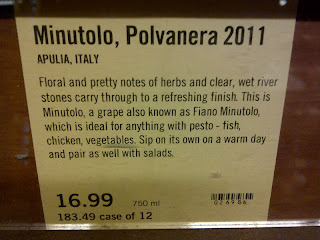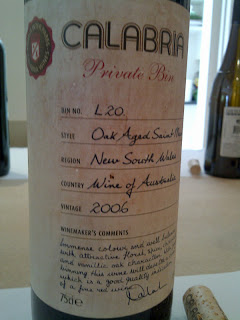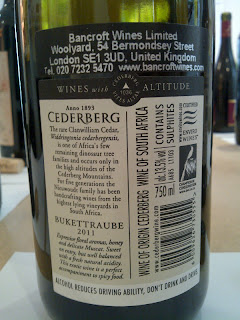In our post of March 24th 2013 we reported on a tasting "North" devoted to wines from Germany, England, Canada, New York State, Northern Italy and so forth. this tasting 4 months later was of mainly Mediterranean and Southern Hemisphere wines.
Again there were surprises and we report below on the winners and losers. Once more the age, condition and provenance of the bottles was a test of the robustness of the wines. Sadly, there were disappointments which should not have been so only because of bottle variation. For example our Rossese failed to shine whereas we had thoroughly enjoyed an identical bottle from the same source only weeks previously.
So here is the balance sheet;
Winners
Chenanson (Grenache/Jurancon Noir cross). Quite a surprise given our exprience with other French crosses which can be very hit an miss affaires. Misses include Caladoc (Grenache/Malbec "Un Grenache qui ne coule pas" - a Grenache that doesn't rot) and Arinarnoa (Merlot/Petit Verdot, two bottles of which we tasted recently with varying degrees of disappointment) with hits including this Chenancon and Marselan (Grenache/Cabernet Sauvignon which we have found consistently pleasurable).
The two variations on Gamay: Gamay de Bouze and Gamay Chaudenay. Our Gamay de Bouze bottle from Henri Marionnet had really been through the wars but emerged unscathed testifying to the robustness of this wine.
The Gamay de Chaudenay from the late lamented Green and Blue Wines of Dulwich was less ancient but also in good shape.
Next came the biggest surprise of the show, the Minutolo from Puglia. This is a quite well known variety in the region although a new one on us. It is full and grapey. It not only proved the white wine popular hit of the tasting but also supplied the Slotovino Award's best white of 12/13. A major discovery we think but it is fair to say more expert opinion wasn't enthusiastic to that degree.
Nero Buono di Cori is obscure even in Lazio and again, this bottle had seen plenty of action before arriving at the tasting. Nonetheless it tasted fresh and robust and was generally admired . Definitely one to seek out where possible.
We liked Rossara although opinion was divided. It was light and pleasant in the Gropello mould but with a character of its own.
Savignon Rosso (aka. Centesimino) from our friends at La Sabbiona (Ravenna) was more generally a hit, even being one of the favourites of those much more expert than us.
Subirat Parent is another light and refreshing white from Catalonia. This sample soon went low - always a good sign.
The Sumoll came in two forms; a savoury red and a pink-ish sweetie. Very pleasant indeed.
We were very taken by the Trepat, another Catalonian which although red, may be used in Cava. We were not alone in this but expert opinion was more doubtful it has to be said.
Losers
Most disappinting was the Cesar, a very minor ingredient of some Burgundies, mainly from Irancy. Thought to be a variety from across the border in Germany known there as Roemer. We hough we had had tasted a Cesar years ago and had kept such a good memory of that particular bottle that we had thrown this variety in to the Slotovino Hall of Fame without further ado. Now we doubt that our ancestral Cesar was the grape; perhaps it had been the proprietorial name of the wine? In any case, on this showing we have to make our first eviction from our Hall of Fame, so out goes this quite nasty, mean and displeasing grape without further ado.
Poor Enantio; so difficult to find - so not worth the effort. Just lacking in any positive attributes really. It is not enough just to be obscure. Boring really.
The Nibio from Luigia Zucchi was sadly over the hill - so much so that it was useless in proving whether it is a Dolcetto or something else altogether. We should reserve judgement on this.
Like Enantio, a Vespolina in purezza is rare indeed but on this showing, not worth the trouble.
We had tried St. Macaire before - a survivor from Bordeaux now only found in Australia. Now as then, it made a very ordinary impression indeed. However more expert opinion found interest in St. Macaire so we should try this again if ever we get the chance.
Like St. Macaire, our St. Jeannet also had a fascinating back story (see notes below) but whether due to a poor bottle or thanks to lack of intrinsic merit, this blend containing St. Jeannet was unable to tell us anything.
Zalema from Huelva seemed as in the past quite hopeless. The reported tendancy to oxydisation is overwhelmingly present in the bottles we have tried. Again the experts were kinder but with the injuction to drink up young.
Not at their best in this showing
Bottles we had enjoyed previously but somehow failed to shine on this occasion included
Arbane, the fantastically obscure Champagne grape that had so impressed when offered to friends previously in the unique version by Moutard. This time, whether due to bottle variation or serving at a different temperature one could have been forgiven for asking what the fuss had been about.
Ribeyrenc; Slotovino's Red of the Year in our 2011/12 Awards was just shy in this company
as was a bottle of Colares Arenae Ramisco - one of our very favourite varieties deserving of greater recognition.
As mentioned the Rossese was not a good bottle
and the Nerello Capuccio bared no resemblance whatsoever to the heavanly example by Benanti which had convinced us that it is this Nerello which should rule rather than Mascalese.
Interesting
Of genuine interest if not of strongly arresting claims were other varieties
Bianco Gentile
Tibouren (which is nothing other than Rossese when grown in France!)
Albanella
Catalanesca
Pallagrello Bianco
Albarin Blanco
Dona Blanca (highly praised by one of the experts)
Montuo/Montua (Chelva)
Tinta Rome
Pais (aka Listan Prieto)
Bukettraube
"South" was always going to be more fun than "North" but there are compensations in both categories. As our old violin teacher used to say, there was good in every school of composition. You only need to seek it out.
That list in full; many thumbnails are courtesy of 'Wine Grapes' for which many thanks.
France
Moutard
Diligent Champagne ARBANE Vieilles Vignes, Buxeuil 2005.
12%
“Old
aromatic but virtually extinct variety from Southern
Champagne” (Wine Grapes) 1 ha. Planted
(2006).
Antoine
Arena BIANCO GENTILE, Corse. NV. 13%
6
ha. Southern Corsica. Re-discovered by Antonio
Arena and others in the mid 1990s.
Domaine
Sorin-Coquard “Cuvee Antique” CESAR, Bourgogne
2011
Aka.
Romain or Römer probably originated in Germany. Not brought over by Julius
Caesar!
Domaine
des Trois Orris CHENANSON, Joep Graler, Languedoc, 2010.
14%
Grenache/Jurancon
Noir cross mostly used in blends.
Element
Terre GAMAY CHAUDENAY, 2007. Vin de table francias. Mis en bouteilles Julien
Courtois, La Cour Moreau, 41230 Soings en Solange.
13.5%
Red-fleshed
mutation of Gamay Teinturier de Bouze.
Les
cepages oublies, Henri Marionnet GAMAY DE BOUZE, La Charmoise, 2006. Vallee du
Cher, Loire. 12%
The
first Gamay Teinturier to be discovered.
Thierry
Navarre, Cepage oublié du Langedoc, RIBEYRENC. Vi n de table francais NV.
Roquebrun, Languedoc.
11%
Aka.
Aspiran Noir. Nearly extinct. Revived by Thierry Navarre. Slotovino red discovery of
the year 2011/12.
Clos
Cibonne TIBOUREN, Cotes de Provence 2011.
14%
TIBOUREN
= Rossese. Grape of St. Tropez. NB. Parts of the South of France belonged to the Kingdom of Savoy until
1860.
Italy
Rocche
del Gatto ROSSESE, Riviera di Ponente 2011.
13%
See
Tibourien
Fattoria
Mancini, Roncaglia ALBANELLA, Colli Pesaresi, 2009.
13%
“Now
confined to the Pesaro region.” (Wine
Grapes)
Cantine
Olivella “Kata” CATALANESCA, I.G.T. del Monte Somma, 2011. Parco Nazionale del Vesuvio,
Italy.
13%
“Very
old high acid white Italian variety suited to both Table and Glass. Exclusive to
Campania”
(Wine Grapes).
Azienda
Agricola Roeno ENANTIO, Terradeiforti, Valdadige, 2007.14%
Formerly
known as Lambrusco a Foglia Frastagliata. Now called Enantio. Rare and difficult
to find.
Soc.
Agricola Polvanera MINUTOLO, Gioia del Colle IGT, Puglia.2011.
12%
Speciality
of Puglia
rescued in 2000 from the brink of extinction by oenologist Lino
Carparelli.
Feudo
di Sant’Anastasia, Randozzo (Catania). ‘Al-Cantara’ NERELLO CAPPUCCIO “La
Fata Galanti” I.G.T. Sicilia. 2010. Italy.
12.5%
Unusual
to be found on its own. Softer than Nerello
Mascalese.
Cantina
Cincinnato NERO BUONO DI CORI, Lazio IGT Rosso, 2006. 13.5%
Castelli
Romani. Usually blended with Montepulciano or
Cesanese.
A.A.
Rugra di Luigia Zucchi, Picula Rusa NIBIO, Tassarola, Gavi (Piemonte), 2008 .
14%
Is
it Dolcetto or a separate variety as Luigia Zucchi
claims?
Vestin
Campagnano PALAGRELLO BIANCO Terre del Volturno I.G.T., 2011,Campania, Italy.
13.5%
Considered
extinct when discovered by Peppe Mancini in the
1990s.
Emilio
Bulfon, PICULIT NERI, delle Venezie IGT2012.
13%
Unrelated
to Picolit; another revival by Emilio Bulfon. He has succeeded in having this
and others included in the Italian national register of
varieties.
Emilio
Bulfon, SCIAGLIN, Pinzano al Tagliamento, Friuli, 2012.
13%
Ancient
variety saved from extinction by Emilio Bulfon.
Zeni
Vigneto Legiare ROSSARA. Campo Rotaliano, Trentino. Vigneti delle Dolomiti,
2010. 11%
Another
offspring of Gouais Blanc. Usuallu blended with Teroldego or
Negrara.
La
Sabbiona SAVIGNÔN ROSSO, Ravenna Rosso I.G.T.,
2010, Faenza.
Italy.
14.5%
Aka.
CENTESIMINO. Revived from some vines which had escaped Phylloxera found in a
garden by Pietro Pianore,
Cantine
del Castello di Castellengo VESPOLINA Coste delle Sesia DOC, 2011. 12.5%
A
progeny of Nebbiolo. Losing ground to Barbera in particular in Piemonte. Example
by kind donation of Ben Bevan.
Greece
Ktima
Yannis Dalamaris, Dalamara Winery NEGOSKA, Regional Wine of Imathia, Greece. 2007.
12.5%
Usually
blended with Xinomavro, Ktima Dalamaris makes a monovarietal in good years such
as this.
Spain
Vinedo
de Alta Montana ‘Nibias’ ALBARIN BLANCO. Vinedas
Chacon Buelta S.L.,Cangas, Asturias, Spain.
14%
“
Very minor variety from the far North of Spain”
(Wine Grapes), 49ha. in 2008.
Gorvia
Quinta da Muradella DONA BLANCA (SIRIA) D.O. Monterrei 2006, 14%
Very
old variety planted in N.W. Spain and Portugal.
Hnos
Lopez Martin S.C. Ribera del Mudejar Vino
Blanco Seco Montuo, MONTUA (CHELVA) Archez, Axarquia (Malaga) 2012.
14.4%
Surprisingly
widely grown in Spain both as table and wine
grapes.
Bodegas
Ponce, Buena Pinta MORAVIA AGRIA (60%),
GARNACHA TINTA (40%), Iniesta, Manchuela, 2011.
13%
MORAVIA
AGRIA “Obscure variety from Esatern Castilla-La Mancha” (Wine Grapes). Sr. Ponce
tells us he will soon produce a 100% MORAVIA
AGRIA.
Finca
Valldosera SUBIRAT PARENT, Massis del Garraf, 2011. Olerdola, Alt Penedes,
Barcelona,
Spain.
12%
Very
old variety from Estramadura in South West
Spain. In Catalunya, it may b used for
Cava.
Heretat
Mont
Rabi Gaintus SUMOLL, Alt Penedes, 2005. 13.5%
Sumoll
= Vijariego Negra from Andalucia. Found mainly in red blends from Catalunya and
Canary
Islands. This dry example is the generous contribution
of Charles Taylor.
Heretat
Mont
Rabi Advent SUMOLL, Alt Penedes, 2008. 15%
This
sweet version is also thanks to Charles
Taylor.
Hnos
Lopez Martin S.C. Ribera del Mudejar TINTA
ROMÉ, Archez, Axarquia (Malaga). 2009, 2007, 2002. 12.7%, 14% &
14.3%
Very
old variety indigenous to Axarquia, Malaga. Many locals use it for home wine
production. Very rare indeed.
Hnos
Lopez Martin S.C. Ribera del Mudejar TINTA ROMÉ
Rosado (Semidulce, Archez, Axarquia (Malaga) 2010.
13.5%
Even
the shop 50m from Bodega Lopez-Martin in Archez does not sell their wines.
Sabores de Andalucia may be the only place they are available other than the
cellar door.
Vinos
Sedella Mediterranean Mountain
Wine TINTA ROMÉ, GARNACHA, 2009. 13.5%
One
of the only wines even containing a proportion of Tinta Romé to be found in a
retail outlet (in this case Lavinia at Malaga
Airport!).
Josep
Foraster TREPAT, Montblanc, Conca de Barberà Denominacio d’origen 2010.
13%
The
first Festa del Trepat was held in 2010 in Barberà de la Conca. May be used as a
constituent of pink Cava.
Vina
Barredero, Blanco Joven, ZALEMA, Condado de Huelva, 2012. Andalucia, Spain.
12%
“Light
and pretty neutral with slight note of almonds and the unfortunate tendancy to
oxydise” (Wine Grapes).
Portugal
Arenae
Colares RAMISCO 2005. Colares, Portugal.
13%
“Demanding
and endangered Portuguese variety” (Wine Grapes). Ungrafted vines. Only 23h.
remaining.
Australia
Calabria
Private Bin ST. MACAIRE, New South
Wales, 2006. 14%
“Obscure
Bordeaux variety
now disappeared from its homeland” (Wine Grapes). Less than 1 ha. remains in
Bordeaux.
South
America
Gardeweg-Lapierre-Luyt,
El PAIS de Quenehuao, Elaborado en bodega de Inia, Cauquenes, Chile
12.5%
Pais
= Listan Prieto. Old variety from Castilla la Mancha taken to
Mexico, California, Chile, Canary Islands and new Mexico. Eradicated by
Phylloxera in Spain.
Finca
El Reposo SAINT JEANNET, Mendoza (40% St.
JEANNET (90 year old vines), 30% Sauvignon Blanc, 30% 90 year old Chardonnay).
2010, 13%
Saint
Jeannet is a village opposite Bellet, 25km from Nice where wine is made in
‘Bonbonnieres’ (large jars). The grape St. Jeannet was taken from there by the
Benegas family in 1912 and planted in Argentina. It no longer exists in St.
Jeannet itself and is now found only on a plot located in Cruz de Piedra,
Mendoza. Only
available in this blend.
South
Africa
Nieuwoudt,
Cederberg BUKETTRAUBE 2011. 13.5%
Bred
in Germany, now most
successful in South
Africa (88
ha.).


















































No comments:
Post a Comment